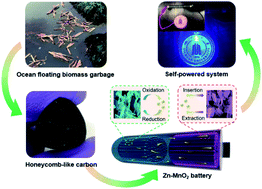High-value utilization of biomass waste: from garbage floating on the ocean to high-performance rechargeable Zn–MnO2 batteries with superior safety†
Abstract
In recent years, the huge consumption of energy and the increasing environmental awareness have triggered the need for new types of devices for the collection and storage of green and renewable energy. Owing to the natural abundance, low cost and renewability, biomass-waste-derived energy storage materials offer a great opportunity to address both energy and environmental issues. Herein, we demonstrate for the first time an effective approach to fabricate a high-performance rechargeable Zn–MnO2 battery directly from biomass garbage (reed straw) floating on the ocean. The obtained three-dimensional (3D) electrodes exhibit a honeycomb-like cellular structure with multi-level open channels. This unique architecture not only enables a high mass loading of MnO2 (51.0 mg cm−3), but also provides low-resistance pathways favorable for electrolyte diffusion and ion transport. The resulting battery achieves a remarkable capacity (369.73 mA h g−1 at a low MnO2 loading of 4.9 mg cm−3 and 306.7 mA h g−1 at a MnO2 loading of 51.0 mg cm−3), good rate capability and outstanding cycling stability (retention of 95.2% of the initial capacity after 3000 cycles), which are superior to those of most batteries of this type. When using a gel as the electrolyte, the as-fabricated quasi-solid-state battery possesses an admirable energy density of 20.5 mW h cm−3 (420.1 W h kg−1, based on the mass of MnO2, or 131.5 W h kg−1 based on the total mass of the battery). Impressively, the battery can be safely used in a wide temperature range (−20 to 100 °C) and under a variety of extreme conditions, such as puncturing, bending, hammering, cutting and cropping. This battery is further integrated with a flexible solar cell for a self-sustaining power bar, which is capable of harvesting green and sustainable energy from the surrounding environment and successfully powers wearable electronics. Unlike most of the previous reports on zinc ion batteries, which attempted to improve the electrochemical properties by using more effective active materials, the present study achieves outstanding performance mainly due to the unique structures of the electrodes derived from the biomass waste. Obviously, this method appears to be much simpler and lower in cost, thus having high potential for scale-up manufacturing.



 Please wait while we load your content...
Please wait while we load your content...